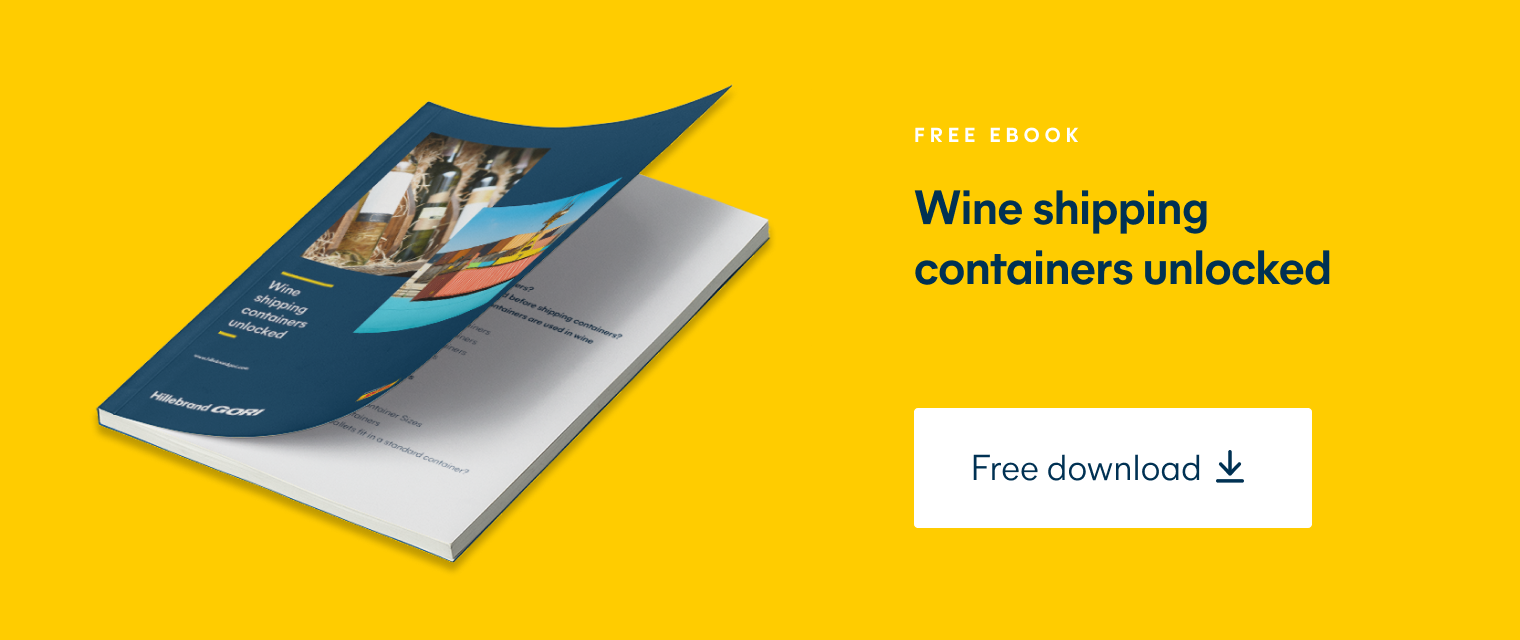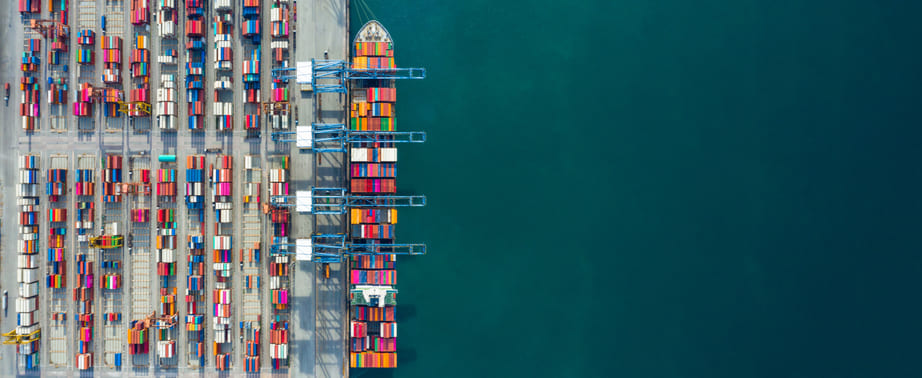Share this post
The secret origin of modern container transportation
Thanks to container transportation, moving your wine by road, rail, or sea is easier, cheaper and efficient. But do you know who pioneered this seamless shipping solution and how exactly it revolutionized the international wine trade? Read on for a brief history of intermodal container transportation.
The history of container transportation
Like many of the inventions that shape our lives, the shipping container had been all but invisible to the general consumer. That was, until a temporary container shortage during the pandemic throttled global trade and showed everyone just how important these humble steel boxes really are.
Sea transportation has always been at the heart of the international wine trade. Three thousand years ago the ancient Phoenicians started shipping wine around the Mediterranean Sea, introducing it to Greece, Spain, Portugal, and other regions now famous for their viticulture. Although over the millennia the clay amphorae used by the ancients, were replaced by wooden barrels and later by glass bottles. The practice of shipping wine from port to port didn’t change much until 1956.
In the US early 1950s, wine, like other products destined for export, would be:
- Loaded by hand onto a truck or freight train at the winery or warehouse
- Transported to the docks
- Unloaded, the contents checked and recorded
- Stored in a transit shed to wait for a ship
In those days, products were transported in containers of all shapes and sizes. When it was time to load the ship, the wine would be hauled from the shed to join crates of other products like fruit, drums of solvents, sacks of animal pelts, or even bags of cement.
The dockworkers were expected to efficiently load ships with these variously packaged goods and make the best use of all available space. This was to maximize profits, but also to ensure the ship was balanced. If the load was not evenly distributed, the ship could capsize in a storm.
The infinite variation in sizes, shapes, weights and densities of goods and containers meant the process was backbreaking, dangerous, and slow. Goods could be stolen, spoiled by cross contamination, or damaged during handling or rough weather in transit. Workers were seriously hurt or killed regularly. Unloading at the other end of a voyage was just as time-consuming and risky. In fact, unloading mixed cargo from a ship and reloading it for an outbound journey could take a week or more. Sometimes ships spent more time docked for loading and unloading than travelling at sea.
The situation for goods travelling inland by truck wasn’t much better. While there was more vehicular traffic than ever before, the US Interstate Highway System was still in the planning stages, and expressways and freeways were few and far between. What’s more, the possible size and length of trucks were severely limited by narrow roads, low tunnels, and weak bridges. The underdeveloped infrastructure meant roads were in danger of reaching capacity.
Transport gridlock was threatening to stifle trade both at sea and on land.
A brief history of containers
Some attempts were made to fix this situation. In the 1920s, a US steamship company pioneered a container transportation service that used cranes to hoist railway boxcars onto their specially designed ships. During World War II, the U.S. military started using standardized container transportation to make the movement of weapons and ammunition safer and more efficient. However, these early experiments failed to catch on with the wider world, and it wasn’t until 1956 that the tide really turned and everything changed.
The first-ever container ship voyage
In the 1950s, Malcom McLean, a trucking entrepreneur from North Carolina, started worrying about the impact the increasing highway congestion was having on his bottom line. McLean decided that the solution was to bypass the roads entirely for the bulk of the journey. He was going to invent an entirely new business model, an integrated transport system using road and water. Coastal shipping was slower than road transport, but thanks to regulations, it was much cheaper. McLean’s plan was to hoist truck trailers full of cargo directly onto repurposed oil tankers. That way, he could sail everything along the coast to another port, where more trucks would be waiting to accept the trailers and take them to their final destinations.
Working with Keith Tantlinger, a talented engineer from California, McLean soon perfected his dreams for container transportation. The two men quickly realized that the simplest and most efficient system would be to use one standardized container which could carry goods on trucks, trains, and ships. Such a one-size fits all design would allow more work to be done by machines, drastically reducing loading and unloading times between one mode of transport and another. The intermodal container concept meant that goods could be packed into one container at the factory or warehouse and stay there until they reached their destination. This saved time, money, and labor and also reduced the risk of losses through damage or theft.
Once he had a plan, McLean had to put it into practice. Among other things, this meant doing some extensive financial wheeler-dealing, purchasing a shipping company or two in dubious circumstances, and retrofitting some WWII oil tankers. He also had to overcome objections from rival truckers and railroad companies, cut through regulatory red tape and convince the US Coast Guard that stacking truck trailers on the decks of ships was a safe prospect.
But eventually, everything was in order, and on the morning of April 26th, 1956 the first modern container ship, the Ideal-X, was docked for loading at the Port of Newark. Every seven minutes a crane loaded a container onto the converted T2 oil tanker. The crane had been especially adapted with a spreader bar invented by Tantlinger, and it loaded 58 containers in less than eight hours. The Ideal-X set sail the same day and five days later arrived at Port Houston, Texas, where it was met by 58 trucks waiting to receive the containers.
The whole operation was a resounding success and modern container transportation was born. industry and helped shape our world today.
Container transportation and McLean’s legacy
What started out as McLean dreaming of moving truck trailers by ship turned into a revolution in freight handling. His innovation changed the whole system from the ships, trucks, trains, and cranes to the design of the ports themselves.
Other trucking companies started copying the container transportation system for their land-based networks. Shipping companies started designing and building container vessels that could be filled with the boxes with virtually no space wasted. The cost of transporting goods plunged.
The model was so successful that just five years after Ideal-X made her momentous journey, regulators and the private sector got together to agree on the international standard container size ‘20-foot-equivalent container unit’, or TEU. This is the basic standard that everyone now uses on their trucks, ships, and trains. Although these days there are some different sizes, such as the 40 feet long version, they can all stack tightly together to use all available space.
By the end of the 1960s, container ships were carrying 1,000 TEU intermodal containers between the continents and the US was using the container transportation system to supply soldiers fighting in Vietnam.
How does container transportation work?
At the winery or warehouse, your wine is usually palletised and loaded into a special food-grade container. Freight forwarders such as Hillebrand Gori offer dry containers, insulated containers and refrigerated containers along with flexitanks and ISO tanks for bulk shipments. The container is bolted shut and fitted with a high-security seal. Trucks, or sometimes trains, deliver FCL or LCL containers to a loading dock where your container will be loaded onto the ship by huge cranes. When the ship docks at the destination port, the containers are unloaded onto the quay by more large quayside cranes. After inspection by customs officials, your container of wine will be transferred to a truck or train and transported to the distribution center.
Thanks to standardization, this whole process has been intensively automatized and streamlined on a global scale. Where it once took days or weeks for dozens or hundreds of longshoremen to handle even small ships, gigantic vessels as large as skyscrapers can be loaded or unloaded in hours by just a handful of crew members.
Today, 90 percent of the world’s goods are transported by sea in containers, mostly between Europe and Asia or across the Pacific. All told, about $14 trillion of the world’s trade involves container transportation at some stage of its journey.
What is the largest container ship today?
The container transportation revolution also encouraged an explosion in the size of cargo ships, with the average dimensions doubling over just the last two decades. As the price per container is so low, shipping lines need to be able to pack as many containers as possible on each journey.
The title of the biggest container ship in the world has passed rapidly from one vessel to another in recent years. The current record holder is Evergreen Marine’s The Ever Ace, which made her maiden voyage in July 2021.
The Ever Ace is 400m (1,312ft) long and has a capacity of 23,992 TEU, which means she can carry 23,992 standard 20-foot intermodal containers. If all those containers were laid end-to-end, the line would measure 44 miles long (70.81 kilometers). Evergreen Marine plans to introduce 12 more ships of identical size.
As impressive as it is, the difference between the Ever Ace and the second and third-largest container ships is slim. The HMM Algeciras, built by Daewoo Shipbuilding, is 399.9m (1312ft) long and can carry 23,964 TEUs, only 28 containers fewer than the number one. The third-largest container ship is the HMM Oslo. She is also 399.9 meters long, although her carrying capacity is 236 TEU less than the Ever Ace.
However, container shipping lines are never satisfied and ships capable of carrying more than 30,000 TEUs are expected to be in operation by 2030. Container transportation certainly has an awe-inspiring future.
How much does it cost to ship a 40 feet container?
If you’re thinking about shipping wine, you might now be asking yourself, exactly how much is a transport container?
While the price of moving a 20-foot container with 20 tons of cargo from Asia to Europe can often be comparable to an economy flight for an airline passenger flying to the same destination, there are a few variables to consider when pricing the shipping of a container.
Factors to take into account include:
- Container type and availability
- The trade route
- Vessel capacity
- The current rate of exchange (ROE)
While international shipping costs were thrown into turmoil by the COVID-19 pandemic, with some exceptions, international freight prices have been falling toward their pre-pandemic levels. The cost of container transportation from China to Northern Europe, for example, fell by two-thirds in 2022.
Work with a freight forwarder you can trust to get the best price and make the most of all the benefits of container transportation. Here at Hillebrand Gori, we can give you detailed and transparent freight quotes based on current market rates. Ask for a transport quote online, or at the office closest to you.





